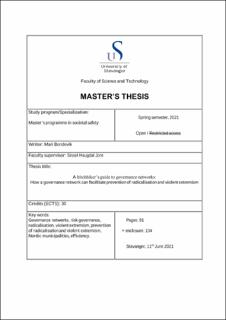| dc.description.abstract | In the Nordic countries, we have increasingly witnessed a model of risk governance that outsources the issue of national security to municipalities and local governments. Municipalities are tasked with tackling radicalisation and violent extremism (RVE), of which they are equipped for to a varying degree. This has created the need for pooling of knowledge and competencies in the effort of preventing RVE. One way of pooling knowledge is through governance networks, which operate as a mode of risk governance. However, there is little knowledge of the value created in such governance networks. Thus, this research seeks to contribute to closing knowledge gap on how governance networks can contribute to prevention of RVE. This explorative study will add empirical meat to a skinny bone.
The research examines the Nordic Safe Cities network, a governance network that operates with the aim of creating safer Nordic cities. This network has 20 member cities from across the Nordic countries, and offers advisory, webinars and knowledge exchange for the municipal coordinators. Through the theoretical framework of governance networks, the value added to local preventive efforts from this network will be examined.
The key findings of this research validate much of the previous knowledge in the field when it comes to how a governance network should be structured in order to be facilitate members’ capacities in prevention work. It sees ten pillars as necessary for the success of a governance network; a governance network will facilitate members’ capacities in prevention of RVE if these pillars are in place. Nevertheless, the lack of evaluations seen in the empirical findings pose challenges to the model for success that this research presents. There is still a long way to go before knowing whether a successful governance network is the same an efficient one, as well as knowing what the real contribution in terms of prevention of RVE-related issues. | |
